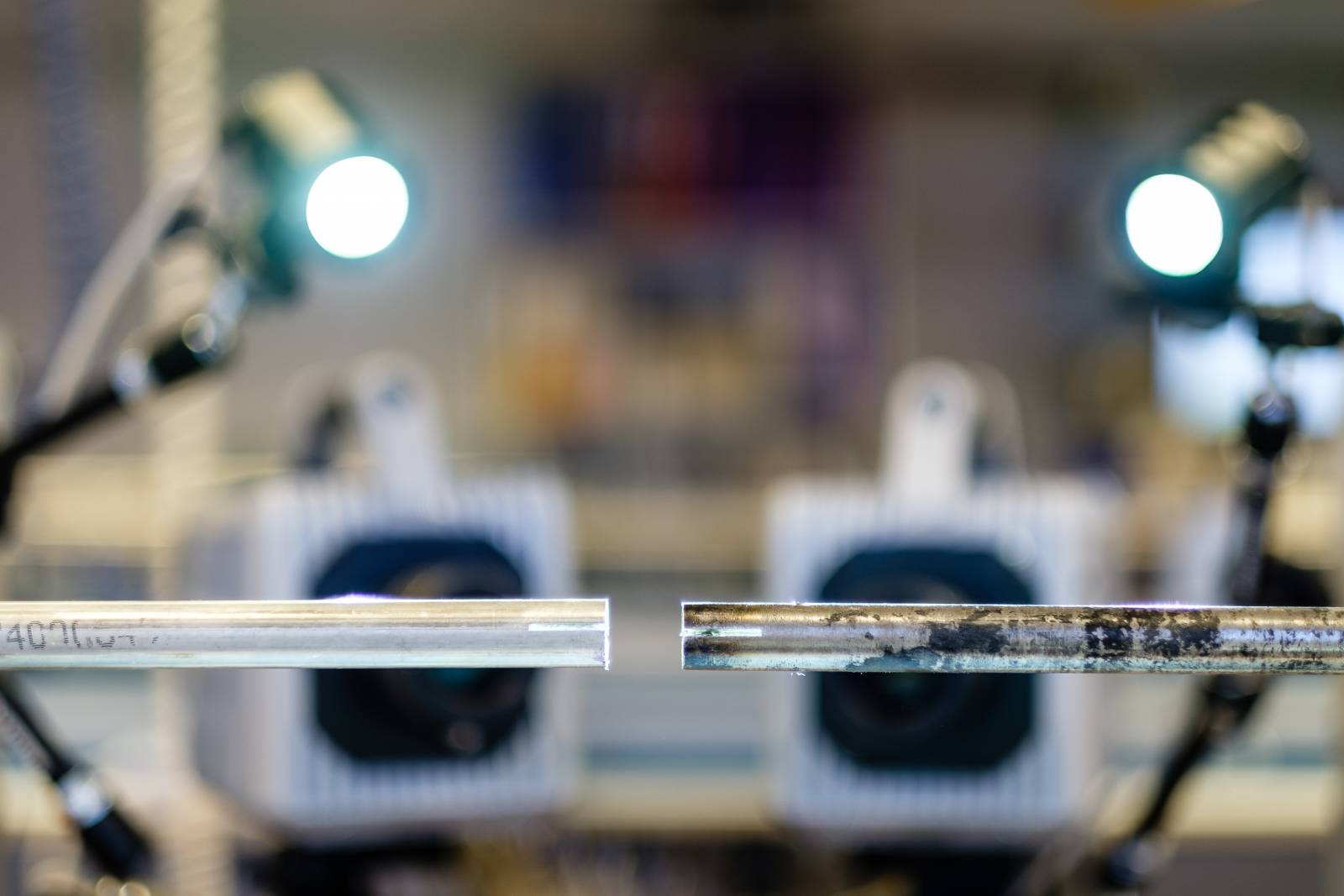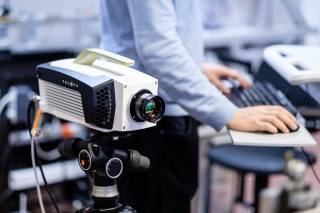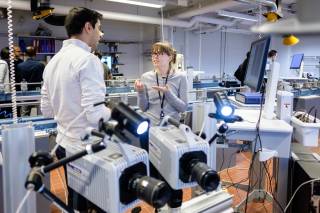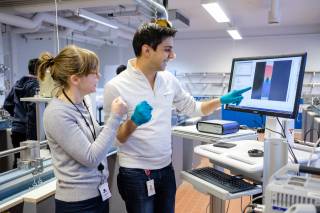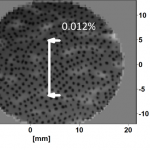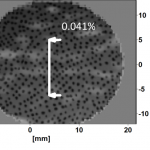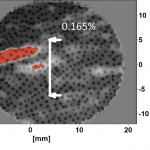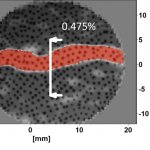In the past, we have experimentally simulated material behaviour in various industrial processes and studied several time dependent phenomena and their effects on material response. We often use high speed photography to record the material behaviour in the experiments, and then use digital image correlation or some other digital image analysis software to study and analyse the material behaviour further. Here are some public examples of our work.
Dynamic Material Behavior in Industrial Processes
Time dependent Brittle Fracture – Percussive Drilling
Mining and excavation of rocks typically involves percussive drilling, which is based on high velocity impact between the drill head and the rock. Optimizing the drilling parameters, such as impact velocity, feed force, rotation between the impacts, can be significantly assisted by numerical simulations and experimentation of the drilling process. Percussive drilling essentially requires sending mechanical energy as a stress pulse from the drill through the drill crown into the rock. The understanding of bit-rock interactions are critically important to optimize the drill parameters so that the rock is destroyed effectively without causing too much damage on the drill equipment. On this topic we have worked together with local and international drilling companies, and participated the NextDrill and InnoDrill consortia focusing on the advancements of deep drilling for geothermal heat. Also a fruitful collaboration with the computational mechanics of structures (Dr. Timo Saksala) of the Civil Engineering department has produced several high-quality publications. Dr. Ahmad Mardoukhi has publicly defended his thesis concerning the effects of microstructural features on the dynamic behavior or rocks in 2017. The thesis can be found here. Other example publications are included here as well:
- Saksala et al. 3D Finite element modeling of percussive rock drilling: Estimation of rate of penetration based on multiple impact simulations with a commercial drill bit. Computers and Geotechnics, vol. 99. 2018.
- Hokka et al. Effects of strain rate and confining pressure on the compressive behaviour of Kuru granite. International Journal of Impact Engineering, vol. 91, 2016.
Time dependent plasticity, adiabatic heating, and high rate failure criteria – machining simulations
The high speed machining of metals is one of the most challenging applications to simulate and experiment realistically. The strain rates are extremely high and can reach up to million per second, adiabatic heating melts the material at the shear zone, and the frictional conditions are extremely difficult to evaluate and measure. Our work focused on experimenting the material behaviour in these challenging conditions, and using modelling and simulation techniques to assist the experiments, we were able to predict and improve the machinability of the Inconel and titanium alloys. We carried out numerous high temperature high strain rate compression tests, and developed mathematical models to simulate the material behavior in the chip formation process during orthogonal cutting. This work included evaluation of time and temperature dependent plasticity and failure at high temperatures. The simulations were carried out at University of Braunschweig.
- Hokka et al. Dynamic Behavior and High Speed Machining of Ti-6246 and Alloy 625 Superalloys: Experimental and Modeling Approaches. Experimental Mechanics, vol. 54, issue 2, 2014.
- Hokka et al. Characterization and numerical modelling of high strain rate mechanical behaviour of Ti-15-3 alloy for machining simulations. Materials Science and Engineering A, vol. 550, 2012.
Time dependent plasticity – Cold heading
Cold heading or upset forging includes hammering a piece of metal at very high speed to a mould, where the metal takes the shape of the mould cavity. The metal flows at very high rate to locally very large strains. In this process, the material must not fail despite the high strains, adiabatic heating, and extreme strain rates. Therefore, identifying the critical failure strains as a function of strain rate and temperature is extremely important. This project included studying the effects of microstructure on the dynamic plasticity, experimental characterization of the dynamic behavior of the material at different strain rates and temperatures, mathematical modeling of the observed behavior, numerical simulations of the industrial process, and finally development of experimental validation tests for the simulations. The outcome is significantly improved understanding of the effects of the material microstructures, loading conditions etc. on the cold heading behavior of the material, which can be directly used to improve the industrial processes.
J. Rämö: Influence of strain rate and adiabatic heating on the deformation behavior of cold heading steels. Journal of Materials Processing Technology, volume 209, Issue 11, June 2009.
Time dependent elastic deformation of polymers – Viscoelasticity
As the speed of paper production is increased, the nip pressure increases and causes viscoelastic deformation on the roll covers materials. It is very important to understand the dynamic response of the roll cover material for proper design of the machine, and also to operate the machine safely. It is important that the viscoelastic deformation is allowed to recover full back to its original shape before the next contact. Our work focused on the mechanical characterization of the viscoelastic properties of the roll cover materials. Together with various modelling approaches we were able to quantify the viscoelastic properties of the materials as a function of deformation and strain rate.
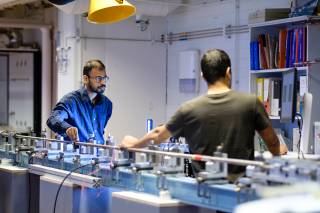
Basic Scientific Research
Effects of strain rate and adiabatic heating on the microplastic mechanisms in steels –the TRIP and TWIP effects
Modern steels can be very strong and at the same time very ductile and formable. This excellent combination of mechanical properties is achieved by very complicated microstructures that evolve very much during the deformation. The active deformation mechanisms are influenced at least by the chemical composition of the steel and its stacking fault energy, strain rate, and temperature. At UTA we have focused our rigorous attention on thermodynamic modelling of the stacking fault energy and its effects on the deformation mechanisms, especially on strain induced twinning and martensitic phase transformations in austenitic steels. Furthermore, we have developed various testing methods to analyse the effects of sudden changes in strain rate, adiabatic heating etc. on the strain induced martensitic phase transformations and twinning. These microplastic mechanisms induce added plasticity on the steel, and proper understanding of the fundamental physics behind the phenomena will assist in developing better TRIP and TWIP aided steels in the future.
S. Curtze et al. Dependence of tensile deformation behavior of TWIP steels on stacking fault energy, temperature and strain rate. Acta Materialia, vol. 58, issue 15, 2010.
S. Curtze et al. Deformation behavior of TRIP and DP steels in tension at different temperatures over a wide range of strain rates. Materials Science and Engineering A, vol. 507, 2019.
Dynamic strain aging in steels
Typically one expects that the strength of a steel drops as temperature is increased. That is not always the case if the deformation includes diffusional movement of solute atoms. In such case the strength of the steel can suddenly increase again at elevated temperatures if the diffusional conditions (strain rate) are suitable. The strength of the phenomena depends strongly on the concentration of the free solute atoms, microstructure of the material, and loading conditions. In our work we carried out high temperature high strain rate tests on selected standard perlitic-ferritic steels. Each steel was heat treated to produce several different microstructure variants with identical (nominal) chemical composition. Based on our work it is quite clear that the heat treatment and the consequently formed microstructure have a strong effect on the strength of the dynamic strain aging, and therefore, the microstructure must be taken into account in further modelling of this phenomenon.
M. Hokka et al. Effects of Microstructure on the Dynamic Strain Aging in Ferritic-Pearlitic Steels. Journal of Dynamic Behavior of Materials. Vol. 4, 2018.

